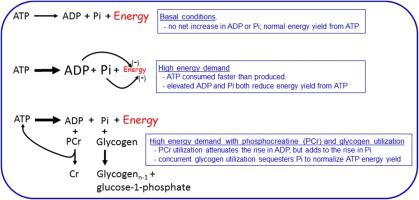当前位置:
X-MOL 学术
›
Prog. Neurobiol.
›
论文详情
Our official English website, www.x-mol.net, welcomes your
feedback! (Note: you will need to create a separate account there.)
A thermodynamic function of glycogen in brain and muscle.
Progress in Neurobiology ( IF 6.7 ) Pub Date : 2020-03-06 , DOI: 10.1016/j.pneurobio.2020.101787 Raymond A Swanson 1
Progress in Neurobiology ( IF 6.7 ) Pub Date : 2020-03-06 , DOI: 10.1016/j.pneurobio.2020.101787 Raymond A Swanson 1
Affiliation

|
Brain and muscle glycogen are generally thought to function as local glucose reserves, for use during transient mismatches between glucose supply and demand. However, quantitative measures show that glucose supply is likely never rate-limiting for energy metabolism in either brain or muscle under physiological conditions. These tissues nevertheless do utilize glycogen during increased energy demand, despite the availability of free glucose, and despite the ATP cost of cycling glucose through glycogen polymer. This seemingly wasteful process can be explained by considering the effect of glycogenolysis on the amount of energy obtained from ATP (ΔG'ATP). The amount of energy obtained from ATP is reduced by elevations in inorganic phosphate (Pi). Glycogen utilization sequesters Pi in the glycogen phosphorylase reaction and in downstream phosphorylated glycolytic intermediates, thereby buffering Pi elevations and maximizing energy yield at sites of rapid ATP consumption. This thermodynamic effect of glycogen may be particularly important in the narrow, spatially constrained astrocyte processes that ensheath neuronal synapses and in cells such as astrocytes and myocytes that release Pi from phosphocreatine during energy demand. The thermodynamic effect may also explain glycolytic super-compensation in brain when glycogen is not available, and aspects of exercise physiology in muscle glycogen phosphorylase deficiency (McArdle disease).
中文翻译:

糖原在大脑和肌肉中的热力学功能。
通常认为脑和肌肉糖原起着局部葡萄糖储备的作用,用于葡萄糖供需之间的短暂失配。但是,定量方法表明,在生理条件下,葡萄糖的供应可能永远不会限制大脑或肌肉中能量代谢的速率。尽管如此,尽管有游离葡萄糖的存在,并且尽管通过糖原聚合物循环葡萄糖的ATP成本,但这些组织在能量需求增加时的确会利用糖原。这种看似浪费的过程可以通过考虑糖原分解对从ATP获得的能量(ΔG'ATP)量的影响来解释。从ATP获得的能量会因无机磷酸盐(Pi)的升高而减少。糖原利用在糖原磷酸化酶反应和下游磷酸化糖酵解中间产物中螯合Pi,从而缓冲Pi的升高,并在快速ATP消耗的位置最大化能量产量。糖原的这种热力学效应在狭窄的,受空间限制的星形胶质细胞过程(包裹神经元突触)以及在能量需求期间从磷酸肌酸释放Pi的细胞(如星形细胞和肌细胞)中尤其重要。当没有糖原时,热力学效应还可以解释大脑中的糖酵解超补偿,以及肌肉糖原磷酸化酶缺乏症(McArdle病)的运动生理学方面。糖原的这种热力学效应在狭窄的,受空间限制的星形胶质细胞过程(包裹神经元突触)以及在能量需求期间从磷酸肌酸释放Pi的细胞(如星形细胞和肌细胞)中尤其重要。当没有糖原时,热力学效应还可以解释大脑中的糖酵解超补偿,以及肌肉糖原磷酸化酶缺乏症(McArdle病)的运动生理学方面。糖原的这种热力学效应在狭窄的,受空间限制的星形胶质细胞过程(包裹神经元突触)以及在能量需求期间从磷酸肌酸释放Pi的细胞(如星形细胞和肌细胞)中尤其重要。当没有糖原时,热力学效应还可以解释大脑中的糖酵解超补偿,以及肌肉糖原磷酸化酶缺乏症(McArdle病)的运动生理学方面。
更新日期:2020-03-06
中文翻译:

糖原在大脑和肌肉中的热力学功能。
通常认为脑和肌肉糖原起着局部葡萄糖储备的作用,用于葡萄糖供需之间的短暂失配。但是,定量方法表明,在生理条件下,葡萄糖的供应可能永远不会限制大脑或肌肉中能量代谢的速率。尽管如此,尽管有游离葡萄糖的存在,并且尽管通过糖原聚合物循环葡萄糖的ATP成本,但这些组织在能量需求增加时的确会利用糖原。这种看似浪费的过程可以通过考虑糖原分解对从ATP获得的能量(ΔG'ATP)量的影响来解释。从ATP获得的能量会因无机磷酸盐(Pi)的升高而减少。糖原利用在糖原磷酸化酶反应和下游磷酸化糖酵解中间产物中螯合Pi,从而缓冲Pi的升高,并在快速ATP消耗的位置最大化能量产量。糖原的这种热力学效应在狭窄的,受空间限制的星形胶质细胞过程(包裹神经元突触)以及在能量需求期间从磷酸肌酸释放Pi的细胞(如星形细胞和肌细胞)中尤其重要。当没有糖原时,热力学效应还可以解释大脑中的糖酵解超补偿,以及肌肉糖原磷酸化酶缺乏症(McArdle病)的运动生理学方面。糖原的这种热力学效应在狭窄的,受空间限制的星形胶质细胞过程(包裹神经元突触)以及在能量需求期间从磷酸肌酸释放Pi的细胞(如星形细胞和肌细胞)中尤其重要。当没有糖原时,热力学效应还可以解释大脑中的糖酵解超补偿,以及肌肉糖原磷酸化酶缺乏症(McArdle病)的运动生理学方面。糖原的这种热力学效应在狭窄的,受空间限制的星形胶质细胞过程(包裹神经元突触)以及在能量需求期间从磷酸肌酸释放Pi的细胞(如星形细胞和肌细胞)中尤其重要。当没有糖原时,热力学效应还可以解释大脑中的糖酵解超补偿,以及肌肉糖原磷酸化酶缺乏症(McArdle病)的运动生理学方面。










































 京公网安备 11010802027423号
京公网安备 11010802027423号